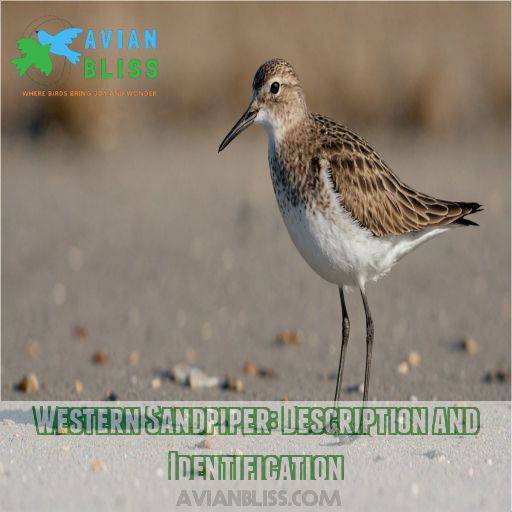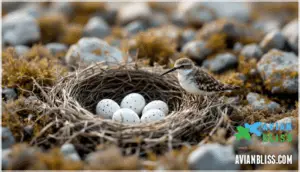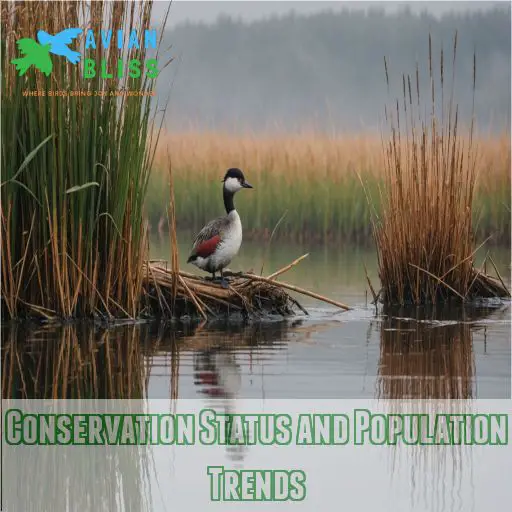This site is supported by our readers. We may earn a commission, at no cost to you, if you purchase through links.

With their slightly drooped bills and seasonal fashion changes (rusty spring attire, gray winter coat), they’re easy to spot on mudflats and beaches.
These adaptable birds aren’t picky eaters, slurping up everything from insects to biofilm. During breeding season, they put on quite a show with aerial acrobatics that’d make any pilot jealous.
But life’s not all sandy beaches for these pint-sized globetrotters – they face some big challenges in their incredible journeys.
Table Of Contents
- Key Takeaways
- Western Sandpiper: Description and Identification
- Range and Migration Patterns
- Habitat Preferences of Western Sandpipers
- Diet and Foraging Behavior
- Breeding and Nesting Habits
- Conservation Status and Population Trends
- Behavior and Adaptations of Western Sandpipers
- Frequently Asked Questions (FAQs)
- Where does the Western Sandpiper live?
- How do you identify a western sandpiper?
- Are Western Sandpipers endangered?
- How long do Western Sandpipers typically live?
- Do Western Sandpipers form large flocks?
- What are their main predators?
- How do they communicate with each other?
- Can Western Sandpipers swim or dive?
- Conclusion
Key Takeaways
- You’ll be amazed by these tiny travelers – at just 6.5 inches long, they punch way above their weight in long-distance migration, flying from Alaska to South America each year. It’s like they’re feathered frequent flyers with millions of air miles.
- Don’t let their small size fool you – these birds are adaptable eating machines. They’ll slurp up everything from insects to biofilm, changing their diet with the seasons. It’s as if they have a built-in Swiss Army knife for foraging.
- You can spot these pint-sized globetrotters by their slightly drooped bills and seasonal fashion changes. In the spring, they sport a rusty look, while winter brings a sleek gray coat. It’s nature’s way of giving them a new wardrobe for each adventure.
- While their population is currently stable at about 3.5 million, these little fighters face big challenges. Climate change and habitat loss are throwing a wrench in their travel plans, making conservation efforts crucial. It’s like Mother Nature is playing a high-stakes game of musical chairs with their stopover sites.
Western Sandpiper: Description and Identification
You’re about to meet one of nature’s tiniest globetrotters: the Western Sandpiper.
Get ready to discover how this pint-sized beach-comber stands out from its feathered friends,
with its unique features and seasonal fashion changes that’ll make even the most seasoned birdwatcher do a double-take.
Physical Characteristics
The Western Sandpiper’s physical characteristics are a clear example of nature’s intricate design.
You’ll spot this tiny traveler by its distinctive bill, longer than its cousin’s and slightly drooped at the tip.
Its plumage shifts with the seasons, sporting rusty marks and black spots in spring, while winter brings a plainer gray-and-white ensemble.
Don’t forget to check those legs – they’re not yellowish like the Least Sandpiper’s!
Size and Measurements
Imagine a feathered golf ball with wings. That’s your Western Sandpiper, measuring just 6.5 inches (17 cm) in length.
You’d need a keen eye to spot these pint-sized travelers during spring and fall migrations.
They’re the smallest among the dull gray sandpipers you’ll find on coastal beaches in winter.
Don’t let their size fool you, though – these tiny titans are built for incredible journeys.
Distinctive Features
You’ll spot Western Sandpipers by their distinctive features. Look for a slightly drooped bill tip, longer than their Semipalmated cousins.
In spring, you’ll notice rusty marks above and black spots on their sides – nature’s fashion statement!
When they take flight, keep an eye out for that white wing stripe. It’s like they’re waving hello as they zoom by on their incredible journeys.
Comparison With Similar Species
Now that you’ve got the hang of spotting Western Sandpipers, let’s tackle the tricky task of telling them apart from their look-alikes.
It’s like a shorebird version of "Spot the Difference"!
Keep an eye on bill length and shape – Western Sandpipers sport a longer, slightly drooped bill compared to their Semipalmated cousins.
Wing shape and leg color are also key clues in this feathered puzzle.
Seasonal Plumage Variations
As you observe Western Sandpipers throughout the year, you’ll notice their remarkable plumage transformations. These tiny travelers sport different feather coats depending on the season:
- Spring breeding plumage: Rusty upperparts with black spots on sides
- Winter attire: Plain gray upperparts with white underparts
- Molting phase: A mix of old and new feathers during the change
- Juvenile plumage: Scaly-looking back with buff-colored edges
These changes help with camouflage and courtship, showcasing nature’s ingenious adaptations.
Range and Migration Patterns
From the tundra to the tropics, Western Sandpipers are true globetrotters. These tiny birds set off on epic journeys that’ll leave you in awe. Imagine flying from Alaska to South America every year – that’s their life! They’re not fans of long ocean flights, so they hop along the coasts in short bursts.
The majority stick to the Pacific side, but some rebels venture to the Atlantic Coast for their winter vacations. With an estimated population of 3.5 million, these frequent flyers are quite the crowd. Partners in Flight gives them a low Continental Concern Score, but don’t let that fool you – their incredible migrations face challenges.
Climate change is throwing a wrench in their travel plans, potentially impacting their range and survival. It’s like Mother Nature’s playing a game of musical chairs with their stopover sites and wintering grounds.
Habitat Preferences of Western Sandpipers
You might think Western Sandpipers aren’t picky about where they hang out, but these tiny travelers actually have some pretty specific habitat preferences.
From their breeding grounds in Alaska to their winter homes in South America, these birds need just the right mix of coastal mudflats, tundra, and wetlands to thrive.
Breeding Grounds
Out on the Alaskan tundra, Western Sandpipers find their perfect love nest.
You’ll spot these tiny travelers setting up shop in dry, flat areas, often tucked under grass tussocks or dwarf birch.
They’re not fussy decorators, lining their cozy scrapes with lichens and leaves.
As climate change threatens their breeding grounds, conservation efforts are vital to make sure these feathered globetrotters have a place to raise their families for years to come.
Wintering Areas
You’ll find Western Sandpipers wintering along coastal areas of North and South America.
These tiny travelers prefer mudflats, shorelines, and beaches where they can feast on insects, mollusks, and crustaceans.
They’re adaptable little birds, making use of salt evaporation ponds and even abandoned shrimp farms.
But watch out! Climate change is threatening their winter homes, impacting food availability and habitat quality.
Conservation efforts are vital to protect these pint-sized globetrotters.
Stopover Sites During Migration
As Western Sandpipers journey from their wintering grounds, they rely on strategic pit stops along the way.
These stopover sites aren’t just random rest areas; they’re carefully chosen refueling stations.
Picture tiny bird airports, bustling with activity! River deltas, tidal estuaries, and sandflats become temporary homes where these feathered travelers can grab a quick bite, catch their breath, and prepare for the next leg of their incredible journey.
Specific Habitat Requirements
- Coastal mudflats for foraging
- Tundra with dwarf birch for nesting
- Shallow wetlands for resting and refueling
Shorebirds are found in areas that tick all these boxes. It’s like they’re on a never-ending quest for the perfect shorebird resort!
Diet and Foraging Behavior
You might think Western Sandpipers are picky eaters, but these tiny travelers have quite the diverse diet.
From insects to biofilm, they’ve adapted clever foraging techniques to fuel their incredible journeys across continents, like the Baird’s Sandpiper’s dependence on insects for energy during migration. foraging techniques.
Primary Food Sources
Western Sandpipers aren’t picky eaters!
These tiny travelers have a diverse menu that changes with the seasons.
During breeding, they’re all about insects and their larvae.
But when they hit the coast, they switch gears to feast on mollusks and crustaceans.
Here’s a fun fact: these little guys also slurp up biofilm – a slimy mix of microbes and organic matter.
Talk about adventurous dining!
Feeding Techniques
The Western Sandpiper’s feeding frenzy is a sight to behold!
These clever birds employ a variety of techniques to snag their next meal.
They’re not picky eaters, probing mud with their bills to extract hidden morsels.
You might catch them slurping up biofilm like it’s a gourmet smoothie.
Males often rely on their eagle eyes for visual hunting, while females prefer the "dig and discover" approach.
Seasonal Dietary Changes
Have you ever wondered how Western Sandpipers adapt their diet throughout the year? These tiny travelers are masters of culinary flexibility, adjusting their menu based on seasonal food availability and migration demands. Here’s a peek into their changing buffet:
- Spring breeding grounds: Insects and larvae take center stage
- Fall migration: Energy-rich invertebrates fuel long flights
- Winter beaches: Mollusks and crustaceans become staples
- Early spring: Biofilm slurping helps prepare for the journey north
You’ll find these pint-sized gourmets making the most of nature’s pantry, wherever their incredible journey takes them.
Adaptations for Foraging
Nature’s little marvels, these birds possess incredible adaptations for finding food.
You’ll marvel at their bill length, perfectly suited for mud probing.
They’re masters of prey selection, expertly sifting through sand and silt.
Regarding food competition, they’ve got tricks up their feathery sleeves.
Their seasonal diet shifts keep them thriving year-round.
It’s like they’ve got a built-in Swiss Army knife for foraging!
Breeding and Nesting Habits
You’re about to discover the fascinating world of Western Sandpiper breeding and nesting habits.
From their unique courtship rituals to their dedicated parental care, these tiny travelers have some impressive tricks up their feathery sleeves in terms of raising the next generation.
Courtship and Pair Formation
You’ve seen how Western Sandpipers fuel up for their journey. Now, let’s peek into their love lives! These tiny travelers are quite the romantics.
Here’s how they woo their mates:
- Males arrive first, staking out prime real estate
- They perform elaborate aerial displays, showing off their flying skills
- Courtship involves quirky sideways approaches and wing-drooping
- Pairs form strong bonds, working together for breeding success
It’s like a beachside dating show, with feathers!
Nest Construction and Site Selection
After the courtship dance, Western Sandpipers get down to business.
They’re picky about their nesting spots, scouting for the perfect patch of dry tundra.
It’s like finding a cozy corner in a vast, featureless landscape.
These clever birds often tuck their nests under grass tussocks or dwarf birches, creating a snug hideaway.
They’ll use leaves, grasses, and lichens to craft a comfy cup about 2.5 inches wide.
Egg-laying and Incubation
The miracle of life unfolds in the Western Sandpiper’s cozy nest.
These tiny travelers lay 2-4 whitish eggs with dark markings, creating a clutch that’s both beautiful and well-camouflaged.
Over the next 21 days, you’ll find both parents taking turns incubating their precious cargo.
It’s a team effort, with mom and dad working tirelessly to keep their eggs safe from sneaky predators like foxes and jaegers.
Parental Care and Chick Development
Once the eggs hatch, Western Sandpiper parents face a new challenge: raising their chicks.
Both mom and dad team up for nest defense, fending off threats with impressive displays of bravery.
As the little ones grow, sibling rivalry might crop up, but parental roles are clear.
Dad often takes the lead in chick-rearing, ensuring fledging success.
It’s a heartwarming sight to see these tiny warriors guiding their fluffy offspring into independence.
Conservation Status and Population Trends
You might be surprised to learn that this tiny shorebird is facing some big challenges.
Let’s explore the Western Sandpiper’s current population status, the threats it’s up against, and what’s being done to help this pint-sized globetrotter survive in a changing world.
Current Population Estimates
You might be wondering how many of these tiny travelers are out there.
Well, according to Partners in Flight, there are about 3.5 million Western Sandpipers strutting their stuff on beaches and mudflats worldwide.
That’s a lot of little feet!
While this number might seem impressive, it’s important to keep an eye on these pint-sized wanderers.
Their population is currently stable, but that doesn’t mean they’re out of the woods just yet.
Threats to Western Sandpipers
Despite their resilience, Western Sandpipers face a gauntlet of threats. Habitat loss due to wetland drainage and invasive cordgrass encroachment tops the list.
You’ll find these tiny travelers battling pollution throughout their range, with climate change lurking as a future menace.
As if that weren’t enough, they’re vulnerable to population crashes due to their concentrated numbers at key migration points. It’s a tough world out there for our feathered friends!
Conservation Efforts and Challenges
Protecting Western Sandpipers is no walk in the park. Conservation efforts face numerous challenges, but there’s hope on the horizon. Here are some key issues and actions:
- Habitat preservation through wetland restoration
- Invasive species control, particularly non-native cordgrass
- Pollution reduction in coastal areas
- International cooperation for migration route protection
- Public education on shorebird conservation
While the journey’s tough, every step counts in safeguarding these tiny travelers. You’ll be amazed at how resilient these birds can be when given a fighting chance!
Impact of Climate Change
Climate change’s grip on the Western Sandpiper’s world is tightening.
Rising sea levels threaten to swallow up important foraging habitats, while shifting weather patterns wreak havoc on migration routes.
These tiny travelers face a double whammy: dwindling food sources and treacherous journeys.
As if that weren’t enough, warmer temperatures are throwing off the delicate timing of their breeding season, potentially leaving chicks high and dry.
It’s a race against time for these feathered underdogs.
Behavior and Adaptations of Western Sandpipers
You’re about to discover the fascinating world of Western Sandpiper behavior and adaptations.
These tiny travelers have some impressive tricks up their feathered sleeves, from their unique flight patterns to their clever ways of avoiding predators.
Flight Patterns and Vocalizations
You’ll be amazed by the Western Sandpiper’s aerial prowess! These tiny birds zip through the skies with rapid wingbeats, their distinctive white wing stripe flashing as they go.
Listen closely, and you might catch their weak trill or "cheet" flight call.
Their streamlined bodies and pointed wings help them navigate long distances, riding air currents to conserve energy during their incredible journeys across continents.
Social Behavior
While Western Sandpipers aren’t known for their melodious songs, they’ve got some pretty interesting social quirks. These pint-sized travelers are all about teamwork in family life. Here’s a peek into their social world:
- Boys club: Males arrive first to stake out prime real estate
- Love in the air: Flashy courtship displays to woo the ladies
- All hands on deck: Both parents share nest duties
- Flying solo: Moms jet off early, leaving dads to finish raising the kids
Predator Avoidance Strategies
When danger lurks, Western Sandpipers have a few tricks up their sleeves.
These tiny travelers rely on their drab plumage for camouflage, blending seamlessly into their surroundings.
They’ll often flock together, using group behavior to confuse predators.
If you spot a nest, don’t be surprised to see parents putting on a brave show of nest defense.
Their erratic flight patterns and sharp alarm calls serve as warning signals, keeping the flock one step ahead of trouble.
Physiological Adaptations for Migration
Western Sandpipers have gone above and beyond in their migration. These tiny travelers pack on the pounds, storing energy as fat for their long journeys.
Their bodies become flight machines, with enlarged hearts and flight muscles.
They’re equipped with an internal compass, using the sun, stars, and Earth’s magnetic field to navigate.
Hormonal changes kick in, triggering seasonal behaviors and physiological shifts that prepare them for the incredible journey ahead.
Frequently Asked Questions (FAQs)
Where does the Western Sandpiper live?
Like a globe-trotting adventurer, you’ll find these tiny travelers nesting in Alaska’s tundra.
They migrate along both coasts of the Americas, wintering in South America.
You’ll spot them on mudflats, shorelines, and beaches during their journey.
How do you identify a western sandpiper?
You’ll spot this tiny sandpiper by its dull gray plumage and long, droopy-tipped bill.
Look for rusty marks and black spots in spring.
In flight, watch for a white wing stripe.
It’s smaller than its coastal cousins.
Are Western Sandpipers endangered?
While you might worry about their status, rest easy. They’re not endangered.
The population’s stable, with about 5 million birds.
Partners in Flight classifies them as "low conservation concern."
Still, they face threats from habitat loss and climate change.
How long do Western Sandpipers typically live?
Ever wondered about these tiny travelers‘ lifespans?
They’re not telling, but scientists estimate 7-10 years for most.
Some lucky birds might celebrate their 15th hatch-day!
It’s a tough world out there for these resilient little wanderers.
Do Western Sandpipers form large flocks?
Imagine this: thousands of tiny wings fluttering in unison.
You’d be amazed at how Western Sandpipers gather in massive flocks, sometimes reaching 100,000 birds!
They’re social creatures, especially during migration and winter months.
It’s quite a spectacle.
What are their main predators?
You’ll find their main predators are foxes and jaegers during nesting season.
On migration and in winter, they’re vulnerable to falcons, hawks, and owls.
Even large fish and crabs can snatch them in shallow waters!
How do they communicate with each other?
Western sandpipers communicate through various vocalizations and visual displays.
You’ll hear their weak trills and "cheet" flight calls.
During courtship, they use body language, like cocking their tails and drooping wings, to signal intentions to potential mates.
Can Western Sandpipers swim or dive?
Though they’re not renowned swimmers, these shorebirds can paddle short distances if needed.
They’ll rarely see them diving, as they prefer to forage in shallow waters or on mudflats, probing for tasty morsels with their bills.
Conclusion
Picture the western sandpiper as a tiny adventurer, carrying a backpack far too big for its size. That’s how these remarkable birds tackle their epic migrations.
You’ve learned about their incredible journeys, adaptable nature, and the challenges they face.
As you walk along a beach or mudflat, keep an eye out for these pint-sized travelers. They’re a reflection of nature’s resilience and the wonders of avian migration.
By understanding and protecting the western sandpiper, we’re safeguarding a small but mighty link in our planet’s intricate ecological web.










